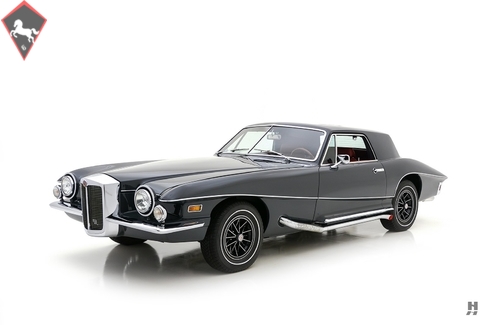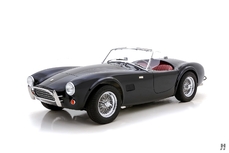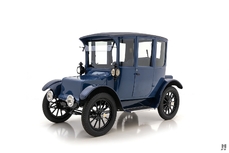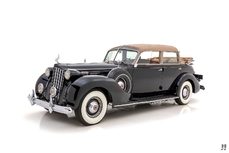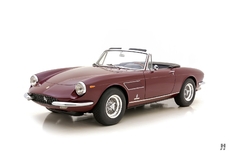Stutz Bearcat Series 1 Coupe 1971
General description :
During his tenure as the head of Chrysler design, Virgil Exner defined the iconic fins & chrome era of the 1950s with his revolutionary “Forward Look” design language. Prior to that, he transformed Chrysler’s stodgy image and introduced American buyers to sophisticated Italian style with the collaborative dream cars created alongside Gigi Segre of Carrozzeria Ghia. Following an acrimonious departure from Chrysler in 1962, he served as a consultant and worked on personal projects. In the mid-1960s, Exner designed a series of so-called “Revival Cars,” which were his interpretations of defunct classic-era automobiles including Mercer, Duesenberg, Bugatti, Pierce-Arrow, Packard, and Stutz. Exner tried and failed to revive Duesenberg, but in 1968, he turned his sights to a rebirth of the Stutz Motor Car Company. Assistance came in the form of Mr. James O’Donnell, a wealthy investor with a particular fondness for Stutz automobiles and a talent for attracting investors. With O’Donnell in charge of the finances, Exner had free-reign on the design, and soon a motorcar worthy of the illustrious Stutz name took form.
Virgil Exner’s vision of the Stutz Blackhawk was realized as a stylish, high-performance grand touring coupe, using American-sourced components in an exclusive, coachbuilt Italian suit. In the spirit of the luxurious and exclusive Dual-Ghia of the 1950s, the original Blackhawk was a fully engineered, hand-built motorcar, not a kit or fiberglass replica. The costly production process involved shipping a complete Pontiac Grand Prix (purchased at retail!) to Carrozzeria Padane in Modena, who discarded the entire body and interior. The new coachwork shared nothing with the donor car, and each completed shell got high-quality paint and luxurious leather and wood trimmings to the buyer’s specification. Those buyers included Dean Martin, Sammy Davis Jr., Lucille Ball, and, most famously, Elvis Presley, who purchased the very first Blackhawk at its debut at the Waldorf Astoria hotel in New York which remains on permanent display in Graceland.
Only 25 of the distinct split-windshield “Series I” Blackhawks were built in 1971, carrying an eye-watering $35,000 price tag – the equivalent of nearly $225,000 today. Regardless, Stutz lost approximately $10,000 per unit before O’Donnell concluded that shipping complete Pontiacs to Italy only to throw half of them away wasn’t the best business plan. From 1972, all subsequent Stutz models used significantly more of the donor car’s substructure, compromising the unique proportions of Exner’s original design, but finally becoming profitable. But it is the early, coachbuilt cars that command the most attention from serious collectors. According to historians, only 16 of the original 25 Blackhawks survive, and they remain as exclusive as they were when new.
On offer is one of the finest examples of the highly exclusive split-windshield Stutz Blackhawk Series I available. This car comes from the private collection of a marque expert and is the subject of an eight-year, nut-and-bolt restoration finished to very high standards. The 17th of 25 produced, this car left the factory in black over a black interior, arriving in North America in November 1971. According to Richard Curotto, the former sales manager of Stutz Motorcars in America, he collected chassis number 276571A172808 at the docks in Quebec, drove it across the border, and continued to Manhattan in time for the New York Auto Show for display. It was sold shortly after the show, but records of the original owners do not exist. The history picks up again in the early 2000s when it was in the hands of famous Elvis impersonator Paul Casey, who cruised the Las Vegas strip in it. In April 2009, Mr. Casey sold the Stutz as a tired but running and driving car to Erik Nielsen of California. The most recent owner acquired it from Nielsen 14 months later, and soon embarked on a painstaking nut and bolt restoration. As a respected expert on these coachbuilt Stutz cars, the new owner spent untold hours sourcing the rare and unique parts lost to time and careless owners. Carrozzeria Padane also built the Maserati Mistral, Indy, and Bora alongside the Stutz, and many components came from the same bins. But some details were particularly challenging to source, including the original Lear Jet stereo 8-track player and the set of five 17-inch Firestone LXX wheels and tires, of which fewer than 50 sets were produced. The Blackhawk was the only car to feature the LXX-system from new. The ultra-rare wheels are included in the sale but are suitable for concours use and low-speed demonstration only.
To best highlight Virgil Exner’s incredible design, the owner chose an attractive shade of Battleship gray. The paintwork is superb and presents beautifully, with excellent body gaps and concours-quality chrome plating on the bumpers, grille, and body trim. Details include period-correct RBT Astro fog lamps, correct chrome dummy side pipes, and proper Kelsey Hayes cast alloy wheels, which the factory retrofitted to every Stutz after reliability issues arose with the Firestone system. It has covered just a few hundred miles since the restoration and remains in outstanding condition all around.
Complementing the marvelous color choice is a lush red leather interior with gorgeous bird’s eye maple accents. Superb, high-quality materials and workmanship features throughout the cabin, with luxuries such as power windows, power sunroof, the original Lear Jet 8-Track stereo, and a modern AM/FM/CD player discreetly integrated into the glovebox. The meticulous restoration included recreating the factory-style fitted luggage behind the seats along with two additional leather-trimmed suitcases in the boot, which also houses a matching jack bag and leather tool roll.
Pontiac had the distinction of offering some of the largest and most powerful engines in the GM lineup. The Grand Prix-sourced 455 cubic-inch V8 was the ideal choice for the Stutz, giving it impressive performance to match the flamboyant style. The 455 in this car is stroked slightly to 461 cubic inches and updated with Edelbrock heads and intake and a high-efficiency serpentine belt system, although the original pulleys and brackets are included to satisfy the purist. The mighty Pontiac V8 produces 425 horsepower, fed through a 3-speed Hydramatic automatic transmission. Power steering, power brakes, and a modern rotary-type air conditioning compressor make for effortless high-speed progress in proper Grand Touring fashion.
With only 16 known survivors, the opportunity to acquire a Series I Stutz Blackhawk is rare, and this example’s superb restoration, overseen by the foremost specialist of the marque, enhances its already desirable stature. The Blackhawk Series I is one of the most uniquely stylish Italian-American hybrids, with the prestige of a handmade Italian body designed by one of the most influential industrial designers of the post-war era.
Offers welcome and trades considered
1971 Stutz Bearcat Series 1 Coupe is listed for sale on ClassicDigest in St. Louis by Hyman Ltd. for $299000.
Car Facts
Car type : Car Make : Stutz Model : Bearcat Model Version : Series 1 Coupe Engine size : 0.0 Model Year : 1971 Sub type : Coupé Location : Missouri Vehicle Registration : Undefined
299000 $
Other cars listed for sale by this dealer
